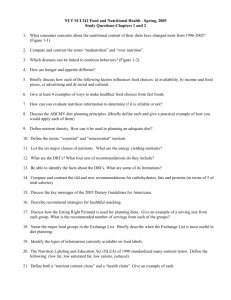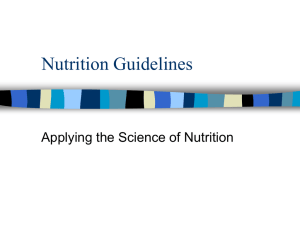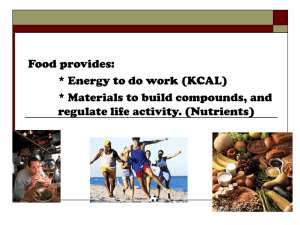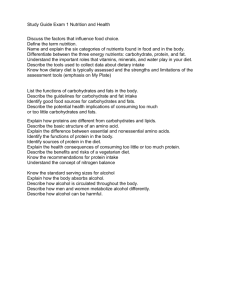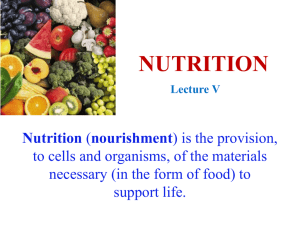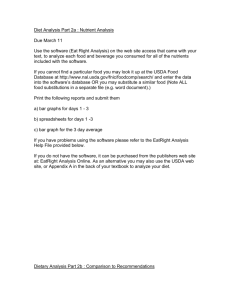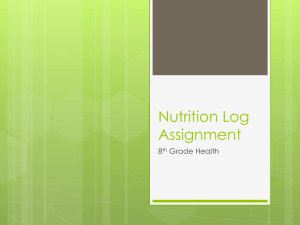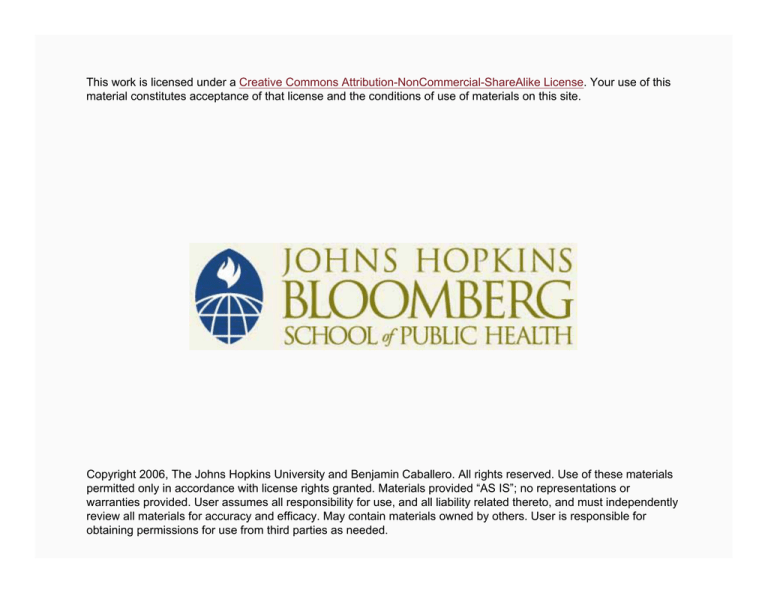
This work is licensed under a Creative Commons Attribution-NonCommercial-ShareAlike License. Your use of this
material constitutes acceptance of that license and the conditions of use of materials on this site.
Copyright 2006, The Johns Hopkins University and Benjamin Caballero. All rights reserved. Use of these materials
permitted only in accordance with license rights granted. Materials provided “AS IS”; no representations or
warranties provided. User assumes all responsibility for use, and all liability related thereto, and must independently
review all materials for accuracy and efficacy. May contain materials owned by others. User is responsible for
obtaining permissions for use from third parties as needed.
Introduction
Benjamin Caballero, MD, PhD
Johns Hopkins University
Section A
Overview of the Course and the Science of Nutrition
Topics
Defining nutritional needs of individuals and groups
Major nutrient groups
− Macronutrients (protein, energy, fat)
− Micronutrients (vitamins, minerals)
Diet and disease—obesity, chronic diseases, undernutrition
Nutrition during the life cycle—pregnancy, newborn, child,
adolescent
4
You Are What You Eat
Giuseppe Archimboldo, The Four Seasons, 1573
5
The Science of Nutrition
Nutrition studies the interaction between the individual and
the environment mediated by food
6
The Science of Nutrition
Areas of Study
Food production
Diet composition (including non-nutritive substances)
Food intake, appetite, food preferences
Digestion and absorption of nutrients
Intermediary metabolism, nutritional biochemistry
7
The Science of Nutrition
Areas of Study
Biological actions of essential nutrients
Nutrient requirements in individuals and populations
Heath effects of nutrient deficiencies and excesses
Long-term effects of diet constituents
Therapeutic and preventive effects of foods
8
Food, Nutrition, and the Body
Environment
Food
Agent
Diet
Host
Body
Food
Nutrition
Body
Production
Distribution
Hygiene
Preparation
Food labels
Meals
Carbohydrates
Proteins
Fats
Vitamins
Minerals
Genetics
Physiology
Lifestyle
Needs
9
What Is a Healthy Diet?
Fulfills energy needs (macronutrients)
Provides sufficient amounts of essential nutrients
(micronutrients)
10
What Is a Healthy Diet?
Fulfills energy needs (macronutrients)
Provides sufficient amounts of essential nutrients
(micronutrients)
Reduces risk of disease
Is safe to consume (low contaminants or potentially harmful
added substances)
11
Evolution of the Human Diet
Huntergatherers
Peasant
agriculturists
15–20
10–15
5
40+
60–75
20
Sugar
25–30
Starch
Protein
50–70
Salt (g/day)
Fiber (g/day)
Notes Available
Modern affluent
societies
15–20
10–15
12
1
40
5–15
60–120
10
20
Fat
12
Section B
DRI, RDA, and EAR
Some Definitions
Requirement
Minimum amount of a nutrient needed to sustain a
physiological state, function, or structure in an individual
14
Some Definitions
Recommendation
Normalized estimate of nutrient needed to cover most
individuals in a population group
15
Some Definitions
Guideline
Advice on diet composition to population groups, aimed at
maintaining health and preventing diseases
16
Nutrient Requirements
“What is the minimum cost per head per week for which food
can be bought in such quantity and in such quality as will
avert starvation disease from the unemployed population?”
— Dr. E. Smith, England, 1862
17
Definition of RDAs
“. . . levels of intake of essential nutrients considered, in the
judgment of the Food and Nutrition Board on the basis of
available scientific knowledge, to be adequate to meet the
known nutritional needs of practically all healthy persons.”
— NRC, 1974, 1980, 1989
18
Sources of Data for Definition of Requirements
Source
Advantages
• Controlled
conditions
• Isolated nutrients
may be studied
Disadvantages
• Small groups
• Short-term
• Inter-individual
variability
Food intake
surveys
• Actual eating
patterns of
populations
• Cultural factors
• Inaccurate
methods
• Lack of food
composition data
Factorial
calculations
• Likely to cover
most of the
population
• Physiologically
sound
• Tends to amplify
errors due to
limited or
inaccurate
information
Metabolic
experiments
19
Dietary Reference Intakes (DRIs)
Estimated Average Requirement (EAR)
Recommended Dietary Allowance (RDA)
Adequate Intake (AI)
Tolerable Upper Intake Level (UL)
20
Scientific Basis for Establishing DRIs
Observed intakes in healthy populations
Epidemiological observations
Balance studies
Depletion/repletion studies
Animal experiments
Biochemical measurements
21
Essential Nutrients
Chemical substances found in food
Necessary for life, growth, and tissue repair
Cannot be synthesized
22
Dietary Reference Intakes
Frequency Distribution
of Individual Requirements
EAR 2 s.d. RDA
Increasing Intake
23
Deficient
1.0
0.5
Estimated Average Requirement (EAR)
Upper Intake Level (UL)
RDA
(AI)
Adequate Intake
1.0
0.5
Risk of Excess
Risk of Inadequacy
Safe Intake Range
Observed Level of Intake
24
Recommended Dietary Allowance
Sufficient to meet the daily nutrient requirements of most
individuals in a specific life stage and gender group
Set at a level that is at the top two to three percent of the
requirement distribution
Intended to serve as a goal for daily intake by individuals
25
Estimated Average Requirement
Average requirement for healthy individuals in which
functional/clinical assessment conducted and adequacy
determined
Limited in number due to few human studies
Half of subjects’ needs met at this level (50% of subjects
would not have their needs met)
26
Relationship of EAR and RDA
RDAsymmetric
= EAR +distribution)
2 SD EAR
(Assumes
27
Section C
AI, UL, and Dietary Guidelines
Adequate Intake
Based on observed or experimentally determined
approximations of the nutrient intake by a defined
population or subgroup that appears to sustain a defined
nutritional state
Can be used as a guide to nutrient intake for the individual
29
Adequate Intake
The AI may exceed the RDA for the same specified endpoint
of nutritional adequacy, if the latter could be determined
The excess of an AI, relative to a true EAR or RDA, is likely to
differ among nutrients, population groups, and distinct
sociocultural settings
30
Adequate Intake
The AI may be used as a goal for nutrient intake for the
individual (it is derived from intakes that appear to sustain a
defined nutritional state)
31
Comparison of the AI with the RDA
Similarities
− AIs and RDAs for individuals
Differences
− Less certainty about AI values (greater degree of
judgment)
− May deviate significantly from and exceed RDA, it if could
be determined
− Use with greater care
32
Tolerable Upper Intake Level
Highest level of daily nutrient intake that is likely to pose no
risks of adverse health effects to almost all individuals in the
general population
Determined by risk assessment methods
Not intended to be a recommended level of intake (no
evidence of benefit for healthy individuals in consuming
nutrients above the RDA or AI)
33
Dietary Guidelines Versus DRIs
Dietary Guidelines
− Qualitative advice to the public about diet and chronic
disease prevention (e.g., the Food Pyramid)
DRIs
− Quantitative advice to professionals about amounts of
nutrients found to be of benefit
34
Dietary Guidelines
USDA, FDA, DGC, NIH, professional organizations
National nutritional and health goals
Implementation of DRI by food assistance programs
Nutrition education
Food industry regulation
35
Criteria for Diet-Disease Relationships
Strength of association
Dose-response relationship
Temporally correct association
Consistency of association
Specificity of association
Biological plausibility
Notes Available
36
Pharmacological Effects of Nutrients
Doses for therapeutic effect exceed levels in food
Pharmacological action different from physiological function
Chemical analogs more effective therapeutically but have no
nutrient activity
Copyright 2005, Benjamin Caballero and The Johns Hopkins University. All rights reserved. Use of these materials permitted
only in accordance with license rights granted. Materials provided “AS IS”; no representations or warranties provided. User
assumes all responsibility for use, and all liability related thereto, and must independently review all materials for accuracy
and efficacy. May contain materials owned by others. User is responsible for obtaining permissions for use from third parties
as needed.
37

